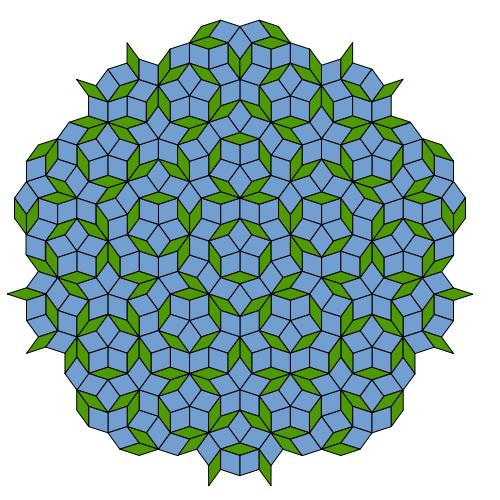The Nobel Prize given to Prof. Danny Shechtman from the Technion describes the mosaic of nature

The Royal Swedish Academy of Sciences has decided to award the 2011 Nobel Prize in Chemistry to the Israeli researcher Daniel Shechtman (Wikipedia) (Daniel Shechtman) from the Technion for the discovery of quasi-periodic crystals or quasi-crystals.
A spectacular mosaic of atoms
in quasi-crystals (The term on Wikipedia), we find the fascinating mosaics found in the Arab art world reproduced time and time again at the atomic level: regular patterns that never repeat themselves. However, the configuration found in quasi-crystals was considered impossible, and Dan Shechtman had to fight a fierce battle against existing science. The 2011 Nobel Prize in Chemistry fundamentally changed the chemical concept of solid matter.
On the morning of April 1982, XNUMX, in Dan Shechtman's electron microscope an image appeared that was completely contrary to the laws of nature. In any solid material, the researchers believed that the atoms are packed inside crystals in symmetrical patterns that repeat themselves cyclically over and over again. For the scientists, the repeatability was a necessary factor in order to obtain a crystal.
The picture Shechtman got, however, showed that the atoms in his crystal were packed in a non-repeating pattern. Such a pattern was considered as impossible as the construction of a football using polygons with only six corners, when a ball requires the use of both pentagons and hexagons for this purpose. Shechtman's discovery was extremely controversial. In the course of defining his findings, he was even asked to leave his research group. However, his persistent struggle eventually forced scientists to reconsider their perception of the fundamental nature of matter.
Aperiodic mosaics, such as those seen in the medieval Islamic mosaics of the Alhambra Palace in Spain and other palaces in Iran, have helped scientists understand that quasi-crystals are similar at the atomic level. In these mosaics, like quasi-crystals, the patterns are regular - they conform to the laws of mathematics - but they never repeat themselves.
When scientists describe Shechtman's quasi-crystals, they use a concept derived from mathematics and art: the golden ratio (The term in Wikipedia). This number was already able to interest the mathematicians of ancient Greece, since it appears widely in geometry. In quasi-crystals, for example, the ratio between the different distances between the atoms refer to the golden mean.
Following Shechtman's discovery, other scientists were able to produce various types of quasi-crystals in the laboratory and also discovered that natural quasi-crystals appear in mineral samples from a Russian river. A Swedish company has also found quasi-crystals in a certain form of steel, with these crystals annealing the material similar to armor. Today, scientists are conducting experiments using quasi-crystals in various products such as frying pans and diesel engines.
Prof. Danny Shechtman of the Technion won the 2011 Nobel Prize in Chemistry

8 תגובות
Very similar to the flower of life:
http://www.ahava528.com/archives/category/%D7%A4%D7%95%D7%A1%D7%98%D7%99%D7%9D/%D7%94%D7%97%D7%99%D7%99%D7%9D/geometry
This opens up a whole new niche of PhD in embroidery science
What practical uses does its discovery have?
Thanks in advance.
In one of the many interviews on the subject today, on the radio, I heard someone describe business
Shleim who produce products based on this discovery - because that's what interested the reporter.
One of these things was the production of special needles that are extremely thin but together
With it very strong for special needs.
Unfortunately I could not listen to the article and concentrate on it.
It is interesting to know about industrial applications for quasi-crystals.
If anyone has more knowledge on the subject.
2011 of course, and thanks to Michael for the correction because I was hardly around the network except for the time when I uploaded the articles.
There is a company called Thomson Reuters and it is a betting company that bets on who will win the Nobel Prizes every year in the different fields of knowledge in the different sciences and it publishes its bets. What is interesting is that Dan Schechtman's name has already appeared several times in the betting exchange for winning the Nobel Prize in previous years and he appeared at Thomson Reuters together with the name of Roger Penrose - who discovered Penrose flooring. That is, they predicted that if Dan Shechtman won the Nobel it would be together with Penrose. The Nobel committee decided to give the prize only to Shechtman for the discovery of quasi-crystals, because he started a completely new field. Please note that Shechtman is the only Israeli Nobel Prize winner among all the ten winners we have had who wins the prize alone without partners. And it is very significant! Because it means he made the breakthrough alone.
I see it has already been fixed.
You can lower your eyebrow.
You wrote in the penultimate link that he "won the Nobel Prize for Chemistry in 1201".
Year 1201? Maybe a Nobel Prize for alchemy...